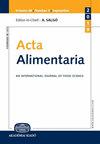超声辅助热水提取香菇可溶性膳食纤维的工艺优化及对stz诱导的糖尿病小鼠的降血脂和抗炎作用分析
IF 1
4区 农林科学
Q4 FOOD SCIENCE & TECHNOLOGY
引用次数: 0
摘要
摘要可溶性膳食纤维(SDF)在促进人体健康方面具有显著的功效。本研究利用响应面法评价超声辅助热水法提取香菇中SDF (U-SDF)的最佳条件,并评价U-SDF的降血脂和抗炎作用。U-SDF的最佳提取条件为超声功率182 W,提取时间2 h,提取温度81℃,料液比1:24 (g mL−1)。在此条件下,U-SDF的提取率达到8.08%。U-SDF处理显著改善糖尿病小鼠肝肾指标,显著降低血浆甘油三酯(TG)、总胆固醇(TC)、低密度脂蛋白-胆固醇(LDL-C)水平,并显著升高高密度脂蛋白-胆固醇(HDL-C)水平,且呈剂量依赖性。U-SDF还能改善糖尿病小鼠脂肪组织损伤,显著降低细胞因子白介素-1β (IL-1β)、白介素-6 (IL-6)、肿瘤坏死因子-α (TNF-α)水平,减轻腹主动脉炎症。综上所述,从L. edodes中提取的U-SDF是一种极好的膳食纤维来源,具有良好的降血脂和抗炎活性,可能作为一种功能性添加剂应用于各种食品中。本文章由计算机程序翻译,如有差异,请以英文原文为准。
Optimisation of ultrasonic-assisted hot-water extraction conditions of soluble dietary fibre from Lentinula edodes and analysis of its hypolipidaemic and anti-inflammatory properties in STZ-induced diabetic mice
Abstract Soluble dietary fibre (SDF) is well recognised for its remarkable effectiveness in promoting human health. This study utilised response surface methodology to evaluate the optimal conditions required to extract SDF (U-SDF) from Lentinula edodes via the ultrasonic-assisted hot-water method, and evaluated the hypolipidemic effects and anti-inflammatory effects of U-SDF. The optimal extraction conditions for U-SDF were ultrasonic power of 182 W, extraction time of 2 h, extraction temperature of 81 °C, and solid-liquid ratio of 1:24 (g mL −1 ). Under these conditions, the extraction rate of U-SDF reached 8.08%. U-SDF treatment significantly improved liver and kidney indices in diabetic mice, markedly reduced the levels of plasma triglycerides (TG), total cholesterol (TC), low-density lipoprotein-cholesterol (LDL-C), and significantly increased the level of high-density lipoprotein-cholesterol (HDL-C) in a dose-dependent manner. U-SDF also improved adipose tissue injury in diabetic mice, significantly decreased the levels of cytokines interleukin-1β (IL-1β), interleukin-6 (IL-6), and tumour necrosis factor-α (TNF-α), and alleviated inflammation of the abdominal aorta. In conclusion, U-SDF from L. edodes is an excellent source of dietary fibres, which exhibit good hypolipidemic and anti-inflammatory activities, suggesting potential applications as a functional additive in diverse food products.
求助全文
通过发布文献求助,成功后即可免费获取论文全文。
去求助
来源期刊

Acta Alimentaria
农林科学-食品科技
CiteScore
1.80
自引率
0.00%
发文量
47
审稿时长
18-36 weeks
期刊介绍:
Acta Alimentaria publishes original papers and reviews on food science (physics, physical chemistry, chemistry, analysis, biology, microbiology, enzymology, engineering, instrumentation, automation and economics of foods, food production and food technology, food quality, post-harvest treatments, food safety and nutrition).
 求助内容:
求助内容: 应助结果提醒方式:
应助结果提醒方式:


